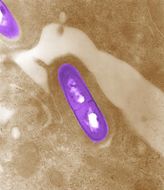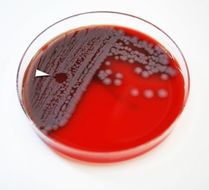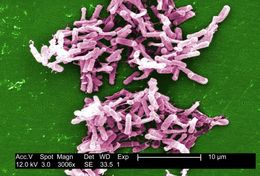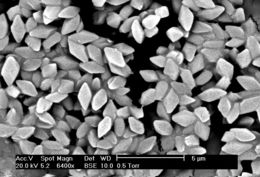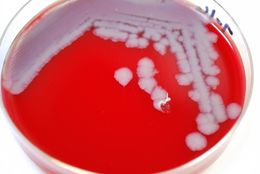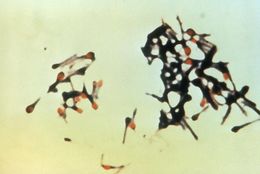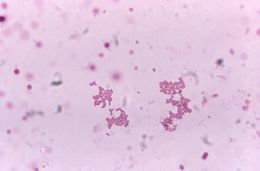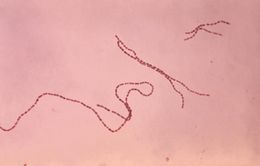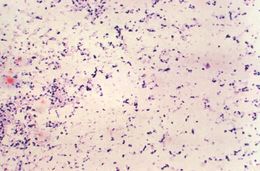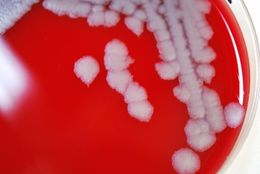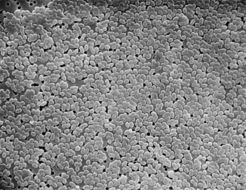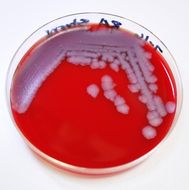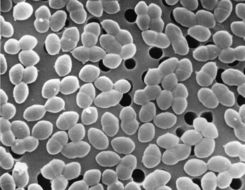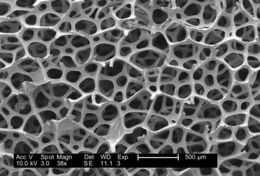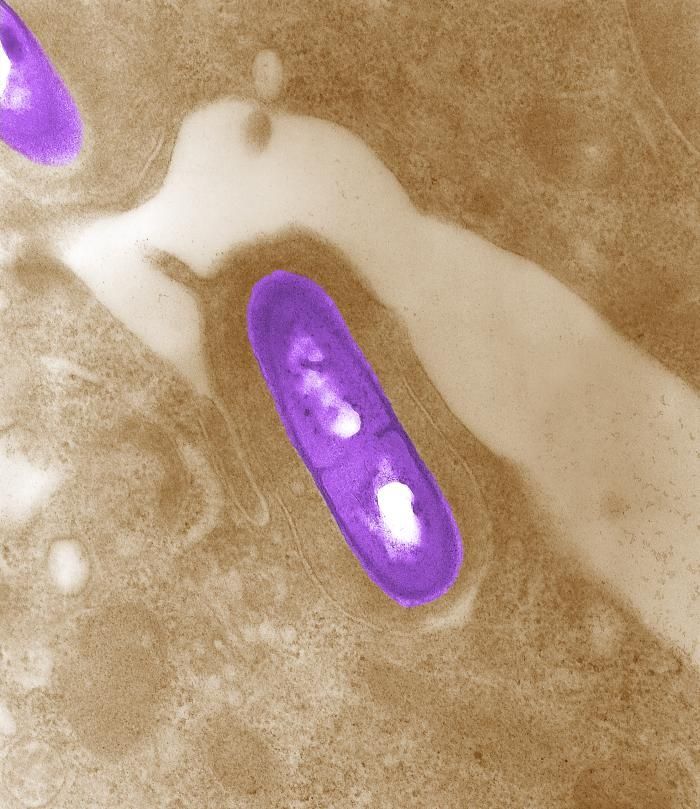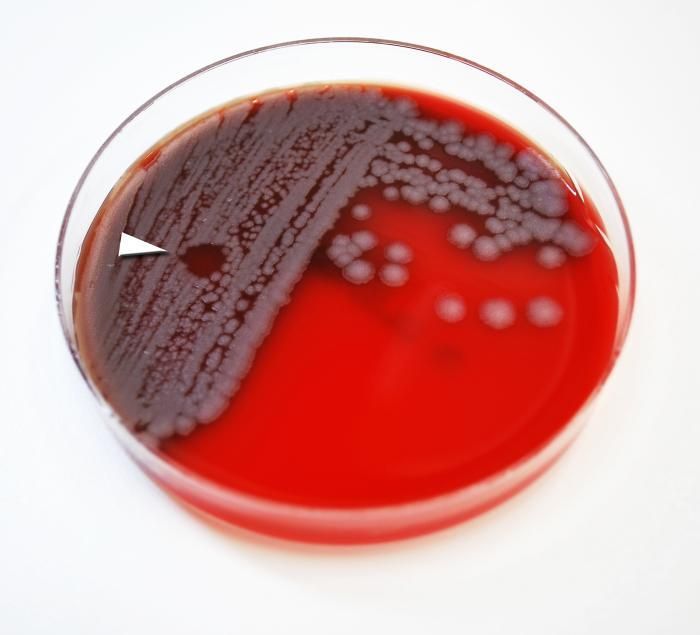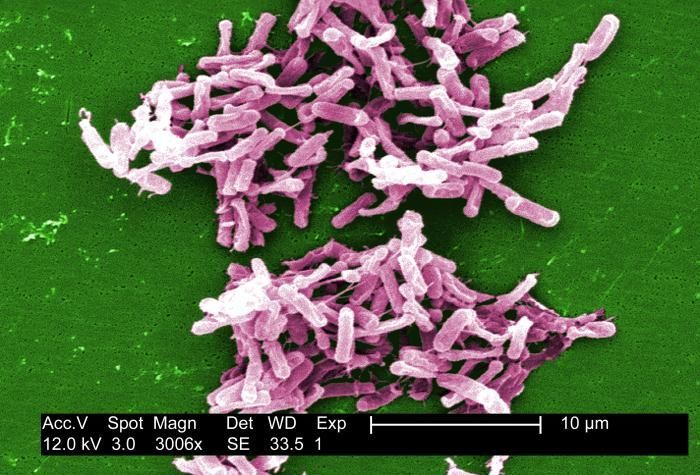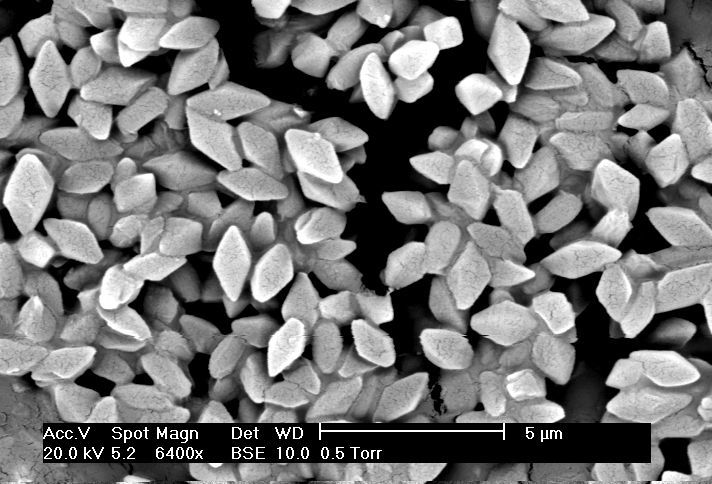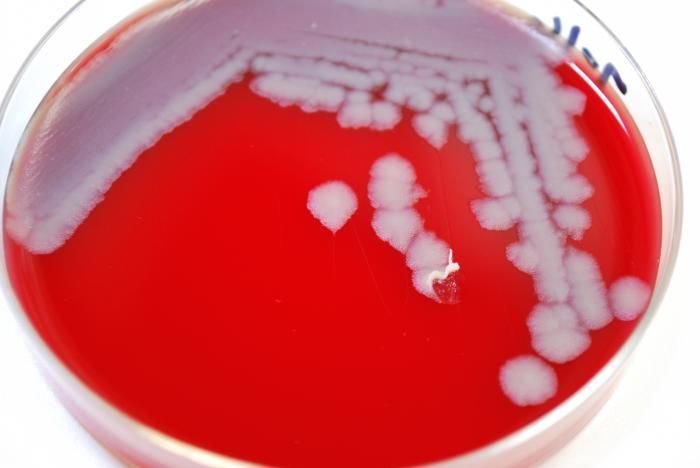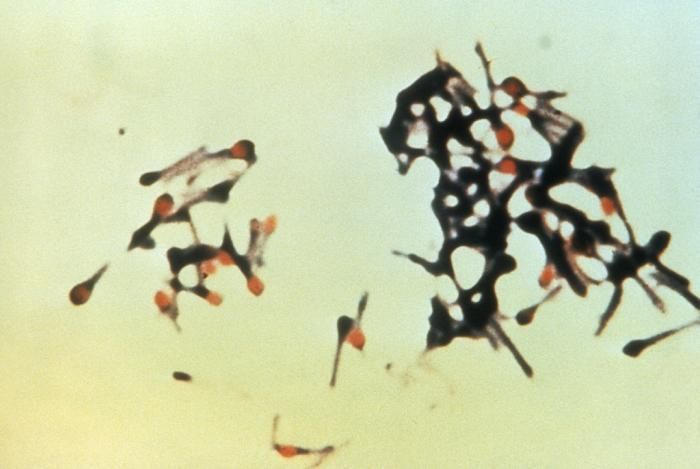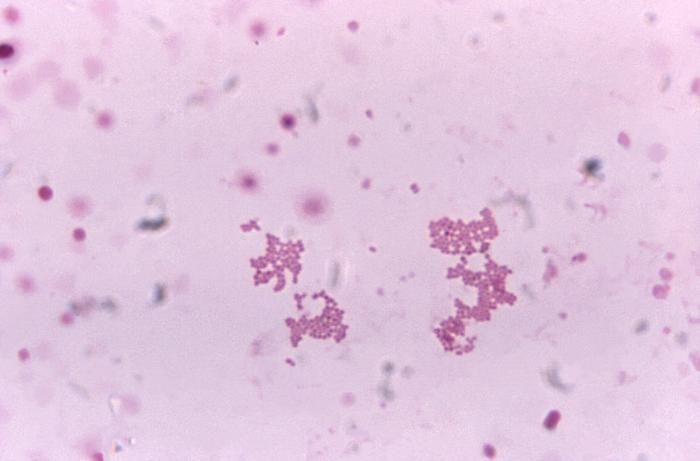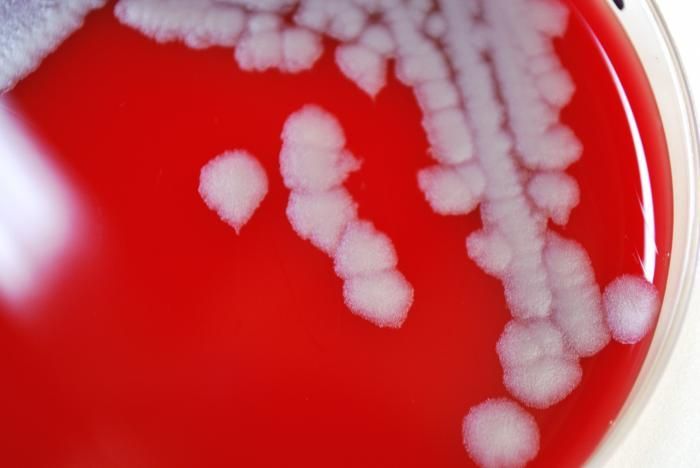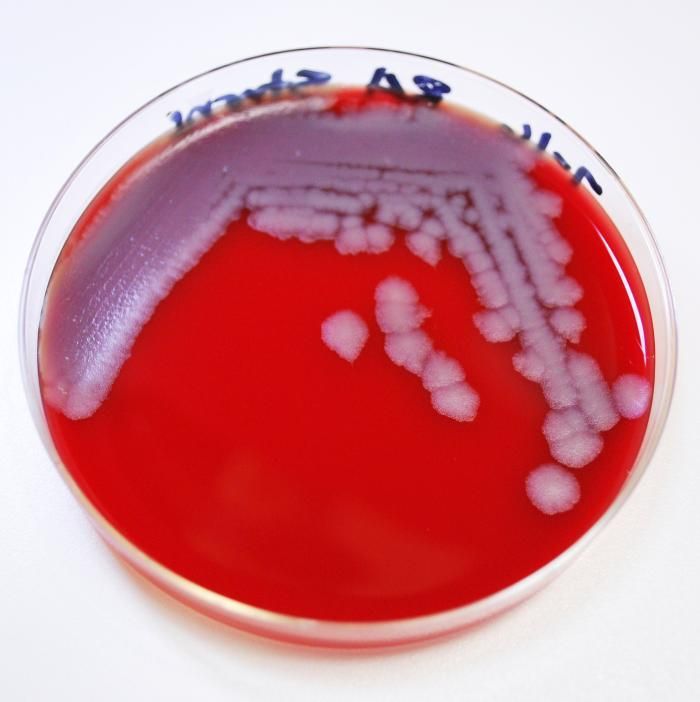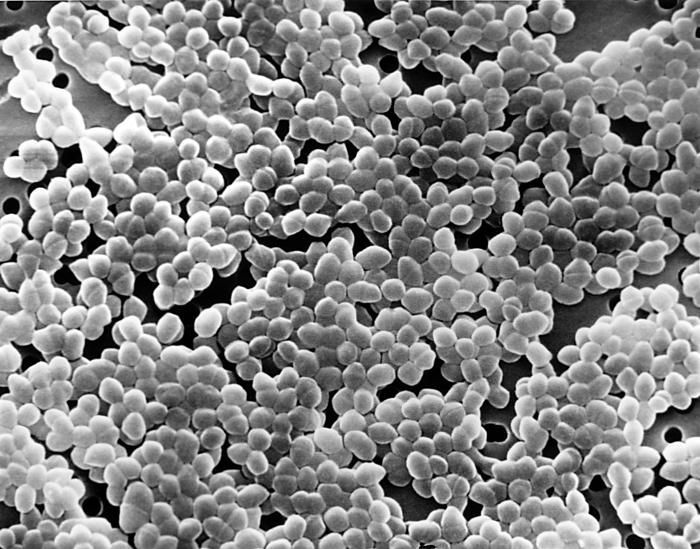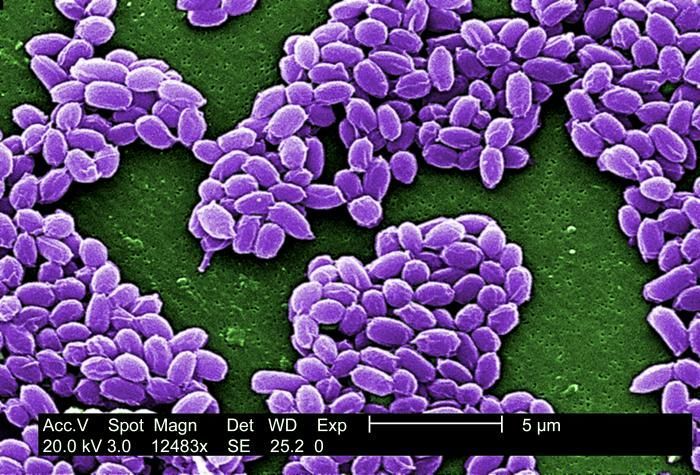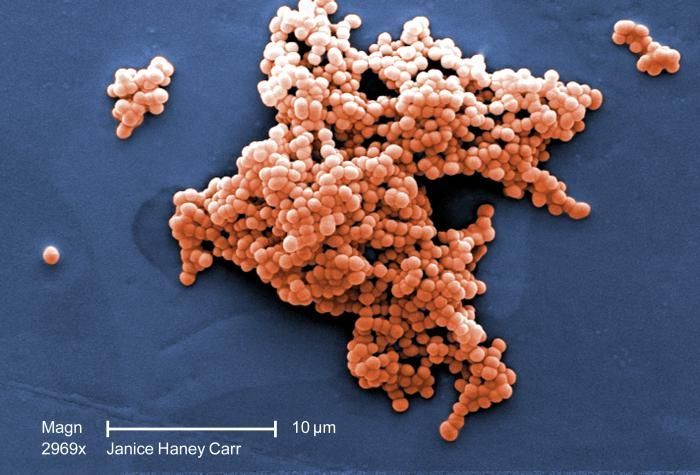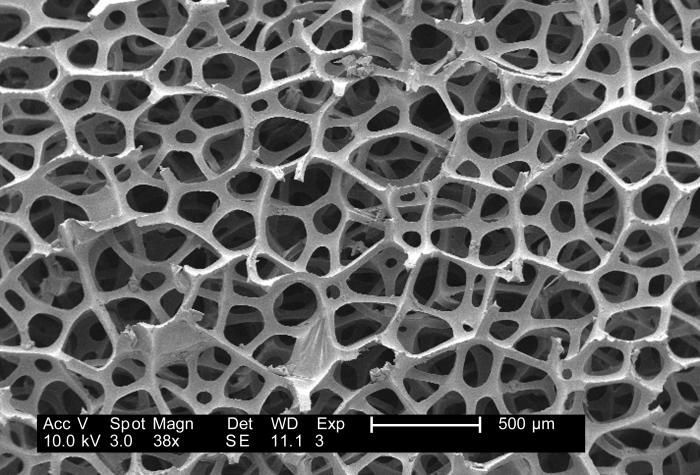-
Electron micrograph of a Listeria bacterium in tissue. See PHIL 2286 for a black and white version of this image.Created: 2002
-
This image depicted numbers of Bacillus anthracis bacterial colonies, which had been allowed to grow on sheeps blood agar (SBA) for a 24 hour period. In this particular view youll note the appearance of what is termed a "plaque" (arrowhead), which represents an area where the bacteria had been lysed, or destroyed by the application of a localized amount of gamma phage-containing solution. Highly specific to B. anthracis, these gamma phage viruses, i.e., bacteriophages, attacked the B. anthracis bacteria, subsequently leaving this circular plaque devoid of bacterial organisms. The specificity of these gamma phages to B. anthracis makes this a positive test for the presence of this bacterium.Created: 2009
-
This micrograph depicts Gram-positive C. difficile bacteria from a stool sample culture obtained using a .1µm filter. See PHIL 6260 for a black and white version of this image.Created: 2004
-
Spores and crystals of Bacillus thuringiensis serovar morrisoni strain T08025 Microscopy by Jim BuckmanFrom
Wikimedia Commons
-
Electron micrograph of a Listeria bacterium in tissue. See PHIL 10828 for a colorized version of this image.Created: 2002
-
This image depicted numbers of Bacillus anthracis bacterial colonies, which had been allowed to grow on sheeps blood agar (SBA) for a 24 hour period. Note the classical appearance exhibited in the colonial morphology including a ground-glass, non-pigmented texture with accompanying comma projections from some of the individual rough-edged colonies. In this particular view, youll note that a tenacity test had been performed using an iinoculating loop, which proved positive for B. anthracis, causing the colony to stand up like beaten egg white.Created: 2009
-
This micrograph depicts Gram-positive C. difficile bacteria from a stool sample culture obtained using a .1µm filter. See PHIL 9999 for a colorized version of this image.Created: 2004
-
This micrograph depicts a group of Clostridium tetani bacteria, responsible for causing tetanus in humans.From
Wikimedia Commons
-
Magnified 1125X, this photomicrograph revealed the presence of numerous Gram-negative anaerobic, gram-negative cocci, i.e., round-shaped, Veillonella sp. bacteria.Created: 1972
-
This image depicted Bacillus anthracis bacterial colonies, which had been allowed to grow on sheeps blood agar (SBA) for a 24 hour period. Note the classical appearance exhibited in the colonial morphology including a ground-glass, non-pigmented texture with accompanying comma projections from some of the individual rough-edged colonies. In this particular view, youll note that a tenacity test had been performed using an iinoculating loop, which proved positive for B. anthracis, causing the colony to stand up like beaten egg white.What is anthrax?Anthrax is an acute infectious disease caused by the spore-forming bacterium Bacillus anthracis. Anthrax most commonly occurs in wild and domestic mammalian species (cattle, sheep, goats, camels, antelopes, and other herbivores), but it can also occur in humans when they are exposed to infected animals or to tissue from infected animals or when anthrax spores are used as a bioterrorist weapon.Created: 2009
-
This 1976 Gram-stained photomicrograph depicted a number of chains of Gram-positive, anaerobic, coccoid (GPAC) Coprococcus eutactus bacteria. Bacteriologist commonly refer to these bacteria as Peptococci or Peptostreptococci.Created: 1976
-
This image depicted Bacillus anthracis bacterial colonies, which had been allowed to grow on sheeps blood agar (SBA) for a 24 hour period. Note the classical appearance exhibited in the colonial morphology including a ground-glass, non-pigmented texture with accompanying comma projections from some of the individual rough-edged colonies. In this particular view, youll note that a tenacity test had been performed using an iinoculating loop, which proved positive for B. anthracis, causing the colony to stand up like beaten egg white.What is anthrax?Anthrax is an acute infectious disease caused by the spore-forming bacterium Bacillus anthracis. Anthrax most commonly occurs in wild and domestic mammalian species (cattle, sheep, goats, camels, antelopes, and other herbivores), but it can also occur in humans when they are exposed to infected animals or to tissue from infected animals or when anthrax spores are used as a bioterrorist weapon.Created: 2009
-
Magnified 1000X, this micrograph depicts numerous Peptostreptococcus sp. bacteria that were grown in Schaedlers broth, and stained using the Gram-stain technique.Created: 1974
-
This image depicted numbers of Bacillus anthracis bacterial colonies, which had been allowed to grow on sheeps blood agar (SBA) for a 24 hour period. Note the classical appearance exhibited in the colonial morphology including a ground-glass, non-pigmented texture with accompanying comma projections from some of the individual rough-edged colonies.What is anthrax?Anthrax is an acute infectious disease caused by the spore-forming bacterium Bacillus anthracis. Anthrax most commonly occurs in wild and domestic mammalian species (cattle, sheep, goats, camels, antelopes, and other herbivores), but it can also occur in humans when they are exposed to infected animals or to tissue from infected animals or when anthrax spores are used as a bioterrorist weapon.Created: 2009
-
Scanning Electron Micrograph of Enterococcus speciesCreated:
-
This image depicted numbers of Bacillus anthracis bacterial colonies, which had been allowed to grow on sheeps blood agar (SBA) for a 24 hour period. Note the classical appearance exhibited in the colonial morphology including a ground-glass, non-pigmented texture with accompanying comma projections from some of the individual rough-edged colonies. See PHIL 11748 for a higher magnification of these colonies.What is anthrax?Anthrax is an acute infectious disease caused by the spore-forming bacterium Bacillus anthracis. Anthrax most commonly occurs in wild and domestic mammalian species (cattle, sheep, goats, camels, antelopes, and other herbivores), but it can also occur in humans when they are exposed to infected animals or to tissue from infected animals or when anthrax spores are used as a bioterrorist weapon.Created: 2009
-
Scanning Electron Micrograph of Enterococcus speciesCreated:
-
Under a magnification of 6,408X, this scanning electron micrograph (SEM) depicted spores from the Aimes strain of Bacillus anthracis bacteria. See PHIL 10124 for a colorized version of this image.Created: 2002
-
This scanning electron micrograph (SEM) depicted numbers of bacteria, which were identified as being Gram-positive Enterococcus sp. bacteria. Previously identified as "Group D" Streptococcus organisms, the most clinically relevant of these bacteria are, E. faecalis, and E. faecium.Created:
-
Under a very high magnification of 31,207X, this scanning electron micrograph (SEM) depicted spores from the Sterne strain of Bacillus anthracis bacteria. For a black and white version of this image see PHIL 2266.Created: 2002
-
Scanning Electron Micrograph of Enterococcus speciesCreated:
-
Under a high magnification of 12,483X, this scanning electron micrograph (SEM) depicted spores from the Sterne strain of Bacillus anthracis bacteria. For a black and white version of this image see PHIL 2267.Created: 2002
-
Under a moderate magnification of 2,969X, this scanning electron micrograph (SEM) revealed a number of clusters of Gram-positive, beta-hemolytic Group C Streptococcus sp. bacteria. See PHIL 10590 for a black and white version of this image.Created: 2008
-
Under a low magnification of 38x, this 2007 scanning electron micrograph (SEM) depicted the fibrous configuration of a dry macrofoam sponge swabs. This swab, as well as three other materials, including polyester (see PHIL 9735), rayon (see PHIL 9734) and cotton (see PHIL 9732, and 9733), were scanned for a CDC study involving their efficiency in recovery of Bacillus anthracis bacterial spores from steel coupons that had been inoculated with a spore suspension of known concentration. See PHIL 9736, 9737, 9738, 9749, 9750, an 9752, for other views of this material. The article discussing the description of this swab material analysis, and the analytical results was published in Emerging Infectious Diseases, Vol. 10, No. 6, June, 2004, and was entitled, Swab Materials and Bacillus anthracis Spore Recovery from Nonporous Surfaces. A link to this article is found below.Created: 2007

